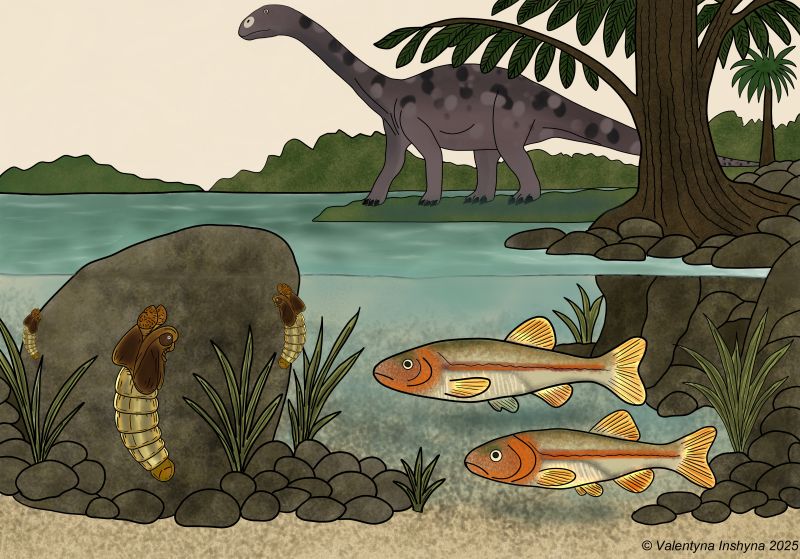A 150-million-year-old fossil with a singular adaptation may unlock the origin of quironomids

An international team of scientists led by the Doñana Biological Station (EBD-CSIC) has described a new species of fossilized insect from the Australian Jurassic period, estimated to be around 151 million years old. It represents the oldest known member in the Southern Hemisphere of the Chironomidae family — non-biting midges that inhabit freshwater environments. The fossil shows a unique evolutionary adaptation: a mechanism, that likely allowing it to firmly anchor to surrounding rocks. Until now, this mechanism was thought to be exclusive to marine species.
The fossilized remains were discovered in the Talbragar fish beds in New South Wales. The research, published in the journal Gondwana Research, included contributions from the Australian Museum Research Institute, the University of New South Wales, the University of Munich, and Massey University, New Zealand.
The fly from the stagnant waters
“This fossil, which is the oldest registered find in the Southern Hemisphere, indicates that this group of freshwater animals might have originated on the southern supercontinent of Gondwana”, explains Viktor Baranov, a researcher at the Doñana Biological Station and first author of the study.
The new species has been named Telmatomyia talbragarica, which translates to "fly from the stagnant waters," reflecting the lacustrine nature of the habitat at Talbragar.
The current research involved analyzing six fossilized specimens —both pupae and eclosing adults— that exhibited a terminal disc. This mechanism, which functions in tide-influenced habitats, was previously thought to be exclusive to marine species. However, sedimentological and paleontological evidence from the Talbragar Fish Beds suggests a freshwater paleoenvironment, highlighting the phenotypic plasticity displayed by chironomids.
New insights on the origin of the family
Podonominae has long been utilized as a model system for biogeographical study, offering an ideal medium to describe and interpret the general patterns governing the distribution and origin of biological diversity.
Initial theories proposed that Podonominae flies originated in Northern Gondwana and later expanded into Laurasia, the supercontinent located in the Northern Hemisphere. However, their fossil record is scarce due to taphonomic biases and the lack of studies focused on fossils from the Southern Hemisphere. Later, the discovery of older fossils in Eurasia, dating from the Jurassic, led to new interpretations suggesting that their origin was in Laurasia.
Now this new study provides compelling evidence that the Podonominae subfamily probably originated in the Southern Hemisphere and later dispersed and expanded globally.
Contemporary Podonominae are found almost entirely in the Southern Hemisphere and their disjunct distribution across South America, Australia, South Africa, and New Zealand represents a classic case of vicariance. This biological phenomenon takes place when a geographical barrier —like a mountain range or a river— divides a species' population, compelling the isolated groups to undergo independent evolution, which results in the creation of new species. According to the hypothesis proposed by Swedish entomologist Lars Brundin in 1966, the Podonominae populations experienced this process after the ancient supercontinent of Gondwana fragmented.
Limitations due to the scarcity of fossils in the Southern Hemisphere
While this discovery addresses a significant gap in the lineage's fossil record, a comprehensive understanding of this group's evolutionary history is still limited by the lack of Southern Hemisphere fossils. The majority of known Podonominae fossils originate from the Northern Hemisphere, with only two prior exceptions documented from the Southern Hemisphere: an Eocene specimen from Australia and a Paleocene record from India.
There is a strong bias towards finding and studying fossils in the Northern Hemisphere. Because of this we end up making incorrect assumptions about where groups originated”, explains Matthew McCurry, palaeontologist from the Australian Museum and The University of New South Wales.
Professor in Massey University Steve Trewick claims, “there are long-standing questions about the way Southern Hemisphere biotas formed and changed through geological time. Fossils species of tiny, delicate freshwater insects like the Talbragar fly are rare and help us interpret the history of life on our planet”.
The analysis of the fossilized specimens, combined with genomics, will help determine whether the dispersal of these insects after the breakup of Gondwana was primarily passive or active. The resulting data will certainly be of value for comprehending and conserving modern-day biodiversity.
Reference
Viktor Baranov, Matthew R. McCurry, André P. Amaral, Robert Beattie, Steven A. Trewick. The oldest Gondwanan non-biting midge (Diptera,Chironomidae, Podonominae) sheds light on the historical biogeography of the clade. Gondwana Research. Doi: https://doi.org/10.1016/j.gr.2025.09.001